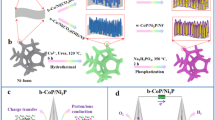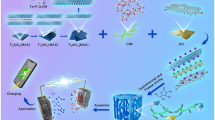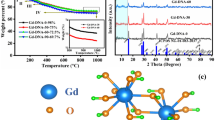Abstract
A highly active and stable oxygen evolution reaction (OER) electrocatalyst is critical for hydrogen production from water splitting. Herein, three-dimensional Ni3S2@graphene@Co92S8 (Ni3S2@G@Co9S8), a sandwich-structured OER electrocatalyst, was grown in situ on nickel foam; it afforded an enhanced catalytic performance when highly conductive graphene is introduced as an intermediary for enhancing the electron transfer rate and stability. Serving as a free-standing electrocatalytic electrode, Ni3S2@G@Co9S8 presents excellent electrocatalytic activities for OER: A low onset overpotential (2 mA·cm−2 at 174 mV), large anode current density (10 mA·cm−2 at an overpotential of 210 mV), low Tafel slope (66 mV·dec−1), and predominant durability of over 96 h (releasing a current density of ∼14 mA·cm−2 with a low and constant overpotential of 215 mV) in a 1 M KOH solution. This work provides a promising, cost-efficient electrocatalyst and sheds new light on improving the electrochemical performance of composites through enhancing the electron transfer rate and stability by introducing graphene as an intermediary.

Similar content being viewed by others
References
Roger, I.; Shipman, M. A.; Symes, M. D. Earth-abundant catalysts for electrochemical and photoelectrochemical water splitting. Nat. Rev. Chem. 2017, 1, 0003.
Ran, J. R.; Zhang, J.; Yu, J. G.; Jaroniec, M.; Qiao, S. Z. Earth-abundant cocatalysts for semiconductor-based photocatalytic water splitting. Chem. Soc. Rev. 2014, 43, 7787–7812.
Dai, L. M.; Xue, Y. H.; Qu, L. T.; Choi, H. J.; Baek, J. B. Metal-free catalysts for oxygen reduction reaction. Chem. Rev. 2015, 115, 4823–4892.
Zheng, M. B.; Zhang, S. T.; Chen, S. Q.; Lin, Z. X.; Pang, H.; Yu, Y. Activated graphene with tailored pore structure parameters for long cycle-life lithium-sulfur batteries. Nano Res. 2017, DOI: 10.1007/s12274-017-1659-3.
Zhang, G. X.; Xiao, X.; Li, B.; Gu, P.; Xue, H. G.; Pang, H. Transition metal oxides with one-dimensional/onedimensional- analogue nanostructures for advanced supercapacitors. J. Mater. Chem. A 2017, 5, 8155–8186.
Zheng, S. S.; Li, X. R.; Yan, B. Y.; Hu, Q.; Xu, Y. X.; Xiao, X.; Xue, H. G.; Pang, H. Transition-metal (Fe, Co, Ni) based metal-organic frameworks for electrochemical energy storage. Adv. Energy Mater. 2017, DOI: 10.1002/aenm.201602733.
Lewis, N. S.; Nocera, D. G. Powering the planet: Chemical challenges in solar energy utilization. Proc. Natl. Acad. Sci. USA 2006, 103, 15729–15735.
Bard, A. J.; Fox, M. A. Artificial photosynthesis: Solar splitting of water to hydrogen and oxygen. Acc. Chem. Res. 1995, 28, 141–145.
Service, R. F. Hydrogen cars: Fad or the future? Science 2009, 324, 1257–1259.
Turner, J. A. A realizable renewable energy future. Science 1999, 285, 687–689.
Zou, X. X.; Zhang, Y. Noble metal-free hydrogen evolution catalysts for water splitting. Chem. Soc. Rev. 2015, 44, 5148–5180.
Tang, C.; Zhang, R.; Lu, W. B.; Wang, Z.; Liu, D. N.; Hao, S.; Du, G.; Asiri, A. M.; Sun, X. P. Energy-saving electrolytic hydrogen generation: Ni2P nanoarray as a high-performance non-noble-metal electrocatalyst. Angew. Chem., Int. Ed. 2017, 56, 842–846.
Fournier, J.; Wrona, P. K.; Lasia, A.; Lacasse, R.; Lalancette, J. M.; Menard, H.; Brossard, L. Catalytic influence of commercial Ru, Rh, Pt, and Pd (0.1 atomic percent) intercalated in graphite on the hydrogen evolution reaction. ChemInform 1992, 23, DOI: 10.1002/chin.199246015.
Wang, X. G.; Li, W.; Xiong, D. H.; Petrovykh, D. Y.; Liu, L. F. Bifunctional nickel phosphide nanocatalysts supported on carbon fiber paper for highly efficient and stable overall water splitting. Adv. Funct. Mater. 2016, 26, 4067–4077.
Lee, Y.; Suntivich, J.; May, K. J.; Perry, E. E.; Shao-Horn, Y. Synthesis and activities of rutile IrO2 and RuO2 nanoparticles for oxygen evolution in acid and alkaline solutions. J. Phys. Chem. Lett. 2012, 3, 399–404.
Zhang, H. C.; Li, Y. J.; Xu, T. H.; Wang, J. B.; Huo, Z. Y.; Wan, P. B.; Sun, X. M. Amorphous Co-doped MoS2 nanosheet coated metallic CoS2 nanocubes as an excellent electrocatalyst for hydrogen evolution. J. Mater. Chem. A 2015, 3, 15020–15023.
Huang, Z. P.; Chen, Z. Z.; Chen, Z. B.; Lv, C. C.; Humphrey, M. G.; Zhang, C. Cobalt phosphide nanorods as an efficient electrocatalyst for the hydrogen evolution reaction. Nano Energy 2014, 9, 373–382.
Liu, T. T.; Liu, Q.; Asiri, A. M.; Luo, Y. L.; Sun, X. P. An amorphous CoSe film behaves as an active and stable full water-splitting electrocatalyst under strongly alkaline conditions. Chem. Commun. 2015, 51, 16683–16686.
Wang, S.; Wang, J.; Zhu, M. L.; Bao, X. B.; Xiao, B. Y.; Su, D. F.; Li, H. R.; Wang, Y. Molybdenum-carbide-modified nitrogen-doped carbon vesicle encapsulating nickel nanoparticles: A highly efficient, low-cost catalyst for hydrogen evolution reaction. J. Am. Chem. Soc. 2015, 137, 15753–15759.
Rowley-Neale, S. J.; Brownson, D. A. C.; Smith, G. C.; Sawtell, D. A. G.; Kelly, P. J.; Banks, C. E. 2D nanosheet molybdenum disulphide (MoS2) modified electrodes explored towards the hydrogen evolution reaction. Nanoscale 2015, 7, 18152–18168.
Huang, J. W.; Li, Y. R.; Xia, Y. F.; Zhu, J. T.; Yi, Q. H.; Wang, H.; Xiong, J.; Sun, Y. H.; Zou, G. F. Flexible cobalt phosphide network electrocatalyst for hydrogen evolution at all pH values. Nano Res. 2017, 10, 1010–1020.
Li, B. B.; Liang, Y. Q.; Yang, X. J.; Cui, Z. D.; Qiao, S. Z.; Zhu, S. L.; Li, Z. Y.; Yin, K. MoO2-CoO coupled with a macroporous carbon hybrid electrocatalyst for highly efficient oxygen evolution. Nanoscale 2015, 7, 16704–16714.
Plaisance, C. P.; van Santen, R. A. Structure sensitivity of the oxygen evolution reaction catalyzed by cobalt(II, III) oxide. J. Am. Chem. Soc. 2015, 137, 14660–14672.
Ma, T. Y.; Dai, S.; Jaroniec, M.; Qiao, S. Z. Metal-organic framework derived hybrid Co3O4-carbon porous nanowire arrays as reversible oxygen evolution electrodes. J. Am. Chem. Soc. 2014, 136, 13925–13931.
Chen, P. Z.; Xu, K.; Fang, Z. W.; Tong, Y.; Wu, J. C.; Lu, X. L.; Peng, X.; Ding, H.; Wu, C. Z.; Xie, Y. Metallic Co4N porous nanowire arrays activated by surface oxidation as electrocatalysts for the oxygen evolution reaction. Angew. Chem., Int. Ed. 2015, 54, 14710–14714.
Wang, Y. Y.; Zhang, Y. Q.; Liu, Z. J.; Xie, C.; Feng, S.; Liu, D. D.; Shao, M. F.; Wang, S. Y. Layered double hydroxide nanosheets with multiple vacancies obtained by dry exfoliation as highly efficient oxygen evolution electrocatalysts. Angew. Chem., Int. Ed. 2017, 129, 5961–5965.
Xu, L.; Jiang, Q. Q.; Xiao, Z. H.; Li, X. Y.; Huo, J.; Wang, S. Y.; Dai, L. M. Plasma-engraved Co3O4 nanosheets with oxygen vacancies and high surface area for the oxygen evolution reaction. Angew. Chem., Int. Ed. 2016, 55, 5277–5281.
Xie, C.; Wang, Y. Y.; Hu, K.; Tao, L.; Huang, X. B.; Huo, J.; Wang, S. Y. In situ confined synthesis of molybdenum oxide decorated nickel-iron alloy nanosheets from MoO4 2-intercalated layered double hydroxides for the oxygen evolution reaction. J. Mater. Chem. A 2017, 5, 87–91.
Liu, Y. Y.; Wang, H. T.; Lin, D. C.; Zhao, J.; Liu, C.; Xie, J.; Cui, Y. A Prussian blue route to nitrogen-doped graphene aerogels as efficient electrocatalysts for oxygen reduction with enhanced active site accessibility. Nano Res. 2017, 10, 1213–1222.
Zhu, J. Q.; Ren, Z. Y.; Du, S. C.; Xie, Y.; Wu, J.; Meng, H. Y.; Xue, Y. Z.; Fu, H. G. Co-vacancy-rich Co1–xS nanosheets anchored on rGO for high-efficiency oxygen evolution. Nano Res. 2017, 10, 1819–1831.
Lu, Q.; Hutchings, G. S.; Yu, W. T.; Zhou, Y.; Forest, R. V.; Tao, R. Z.; Rosen, J.; Yonemoto, B. T.; Cao, Z. Y.; Zheng, H. M. et al. Highly porous non-precious bimetallic electrocatalysts for efficient hydrogen evolution. Nat. Commun. 2015, 6, 6567.
Lu, Z. Y.; Zhu, W.; Yu, X. Y.; Zhang, H. C.; Li, Y. J.; Sun, X. M.; Wang, X. W.; Wang, H.; Wang, J. M.; Luo, J. et al. Ultrahigh hydrogen evolution performance of under-water “superaerophobic” MoS2 nanostructured electrodes. Adv. Mater. 2014, 26, 2683–2687.
Huang, J. L.; Hou, D. M.; Zhou, Y. C.; Zhou, W. J.; Li, G. Q.; Tang, Z. H.; Li, L. G.; Chen, S. W. MoS2 nanosheet-coated CoS2 nanowire arrays on carbon cloth as three-dimensional electrodes for efficient electrocatalytic hydrogen evolution. J. Mater. Chem. A 2015, 3, 22886–22891.
Xie, L. S.; Zhang, R.; Cui, L.; Liu, D. N.; Hao, S.; Ma, Y. J.; Du, G.; Asiri, A. M.; Sun, X. P. High-performance electrolytic oxygen evolution in neutral media catalyzed by a cobalt phosphate nanoarray. Angew. Chem., Int. Ed. 2017, 56, 1064–1068.
Jiang, P.; Liu, Q.; Sun, X. P. NiP2 nanosheet arrays supported on carbon cloth: An efficient 3D hydrogen evolution cathode in both acidic and alkaline solutions. Nanoscale 2014, 6, 13440–13445.
Li, S. W.; Wang, Y. C.; Peng, S. J.; Zhang, L. J.; Al-Enizi, A. M.; Zhang, H.; Sun, X. H.; Zheng, G. F. Co-Ni-based nanotubes/nanosheets as efficient water splitting electrocatalysts. Adv. Energy Mater. 2016, 6, 1501661.
Zhang, Y. Q.; Ouyang, B.; Xu, J.; Chen, S.; Rawat, R. S.; Fan, H. J. 3D porous hierarchical nickel-molybdenum nitrides synthesized by RF plasma as highly active and stable hydrogen-evolution-reaction electrocatalysts. Adv. Energy Mater. 2016, 6, 1600221.
Xu, R.; Wu, R.; Shi, Y. M.; Zhang, J. F.; Zhang, B. Ni3Se2 nanoforest/Ni foam as a hydrophilic, metallic, and selfsupported bifunctional electrocatalyst for both H2 and O2 generations. Nano Energy 2016, 24, 103–110.
Sivanantham, A.; Ganesan, P.; Shanmugam, S. Hierarchical NiCo2S4 nanowire arrays supported on Ni foam: An efficient and durable bifunctional electrocatalyst for oxygen and hydrogen evolution reactions. Adv. Funct. Mater. 2016, 26, 4661–4672.
Dong, Q. C.; Sun, C. C.; Dai, Z. Y.; Zang, X. X.; Dong, X. C. Free-standing NiO@C nanobelt as an efficient catalyst for water splitting. ChemCatChem 2016, 8, 3484–3489.
Dong, Q. C.; Wang, Q.; Dai, Z. Y.; Qiu, H. J.; Dong, X. C. MOF-derived Zn-doped CoSe2 as an efficient and stable free-standing catalyst for oxygen evolution reaction. ACS Appl. Mater. Interfaces 2016, 8, 26902–26907.
Sun, C. C.; Dong, Q. C.; Yang, J.; Dai, Z. Y.; Lin, J. J.; Chen P.; Huang, W.; Dong, X. C. Metal-organic framework derived CoSe2 nanoparticles anchored on carbon fibers as bifunctional electrocatalysts for efficient overall water splitting. Nano Res. 2016, 9, 2234–2243.
Dong, X. C.; Xu, H.; Wang, X. W.; Huang, Y. X.; Chan-Park, M. B.; Zhang, H.; Wang, L. H.; Huang, W.; Chen, P. 3D graphene-cobalt oxide electrode for high-performance supercapacitor and enzymeless glucose detection. ACS Nano 2012, 6, 3206–3213.
Meng, S. J.; Wu, M. Y.; Wang, Q.; Dai, Z. Y.; Si, W. L.; Huang, W.; Dong, X. C. Cobalt oxide nanosheets wrapped onto nickel foam for non-enzymatic detection of glucose. Nanotechnology 2016, 27, 344001.
Zhou, W. J.; Wu, X. J.; Cao, X. H.; Huang, X.; Tan, C. L.; Tian, J.; Liu, H.; Wang, J. Y.; Zhang, H. Ni3S2 nanorods/Ni foam composite electrode with low overpotential for electrocatalytic oxygen evolution. Energy Environ. Sci. 2013, 6, 2921–2924.
Feng, L. L.; Fan, M. H.; Wu, Y. Y.; Liu, Y. P.; Li, G. D.; Chen, H.; Chen, W.; Wang, D. J.; Zou, X. X. Metallic Co9S8 nanosheets grown on carbon cloth as efficient binder-free electrocatalysts for the hydrogen evolution reaction in neutral media. J. Mater. Chem. A 2016, 4, 6860–6867.
Dou, S.; Tao, L.; Huo, J.; Wang, S. Y.; Dai, L. M. Etched and doped Co9S8/graphene hybrid for oxygen electrocatalysis. Energy Environ. Sci. 2016, 9, 1320–1326.
Acknowledgements
The work was supported by the National Natural Science Foundation of China (NSFC) (Nos. 61525402 and 5161101159), Key University Science Research Project of Jiangsu Province (No. 15KJA430006), QingLan Project, National Postdoctoral Program for Innovative Talents (No. BX201600072), China Postdoctoral Science Foundation (No. 2016M601792).
Author information
Authors and Affiliations
Corresponding authors
Electronic supplementary material
12274_2017_1754_MOESM1_ESM.pdf
Graphene as an intermediary for enhancing the electron transfer rate: A free-standing Ni3S2@graphene@Co9S8 electrocatalytic electrode for oxygen evolution reaction
Rights and permissions
About this article
Cite this article
Dong, Q., Zhang, Y., Dai, Z. et al. Graphene as an intermediary for enhancing the electron transfer rate: A free-standing Ni3S2@graphene@Co9S8 electrocatalytic electrode for oxygen evolution reaction. Nano Res. 11, 1389–1398 (2018). https://doi.org/10.1007/s12274-017-1754-5
Received:
Revised:
Accepted:
Published:
Issue Date:
DOI: https://doi.org/10.1007/s12274-017-1754-5




